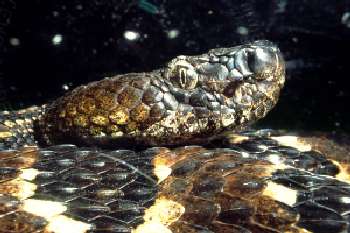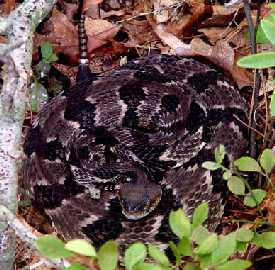| New Jersey Division of Fish and Wildlife |
The timber rattlesnake may arguably be among the state's most endangered species. They occur in relatively small numbers in the few remaining remote and rugged areas of the state. They are often the targets of wanton killing and suffer continued persecution from illegal collecting.

Rattlesnakes have a low reproductive potential because females reach maturity at a late age, they usually reproduce only once every three to four years, and they have small litters. Habitat destruction and alteration and human encroachment into timber rattlesnake habitat are currently considered the greatest threats to their survival in New Jersey. More information about rattlesnakes is available in our new "Field Guide to Reptiles and Amphibians of New Jersey".
Presently there are research efforts underway to help protect this endangered species. The latest effort in the Pinelands relies on sighting information from the public. To help with the identification of this species please see the excerpt from the field guide which is in PDF format (94kb - requires the Adobe Acrobat Reader, available free from Adobe's Website).
The general methodology for the Pineland Timber Rattlesnake Study will include capturing adult rattlesnakes throughout the Pinelands, implanting them with radio transmitters, and tracking these snakes to their hibernacula using radio-telemetry techniques. Rattlesnakes will be captured opportunistically by ENSP biologists based on snake reports by homeowners or other field workers. A combination of ground and aerial telemetry techniques will be used.
Implanted rattlesnakes used in this study move freely (without being tracked) until the fall. In early October the general locations of implanted snakes will be determined from a low-flying aircraft equipped with standard telemetry equipment. Ground-based telemetry will then be used to find the exact locations of these snakes and daily monitoring will be conducted until the study snakes enter their hibernacula. Hibernaculum locations will then be mapped using GPS technology.

In order for the Pinelands Timber Rattlesnake project to be successful public involvement is crucial, in fact it is the key to its success. ENSP biologists are depending on residents and visitors to New Jersey to report any rattlesnakes they come across while in the Pinelands. Biologists hope to capture snakes that are reported and use these snakes in their study.
If you see a rattlesnake, ENSP asks that you take the following actions:
1) Stay calm and keep your distance from the snake.
2) If possible, have someone watch over the snake while you call to report the sighting.
3) Report the sighting to the Division of Fish & Wildlife immediately by calling 1-877-WARN DEP.
Keep in mind that ENSP biologists are hoping to incorporate any rattlesnakes you report into their study so it is important that you notify them immediately if you see a snake.
Like the study being in conducted in the Pinelands, the ENSP is relying on public involvement, and the cooperation of municipal animal control officers, local police departments, and state park rangers and law enforcement to locate rattlesnakes. Please follow the same steps listed above in the "Pinelands" section if you find a rattlesnake in the northern region.
This study is modeled after the Pinelands project and will include implanting snakes with transmitters and tracking them using radio telemetry to locate their dens.